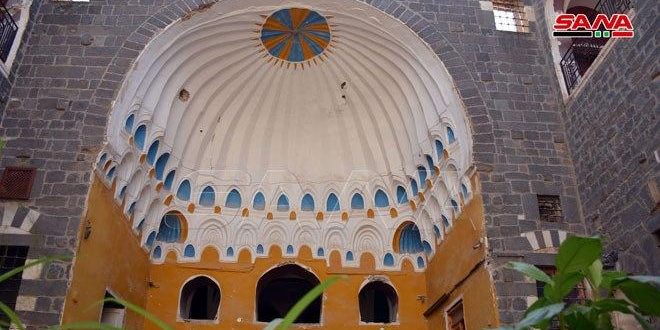Al-Zahrawi Palace, which is one of the most famous monuments in the city of Homs, is currently witnessing restoration work to remove the vandalism and looting it was subjected to by terrorist organizations.
The palace is characterized by its beautiful architectural style dating back to the Mamluk era. Above one of the halls of the two-story palace, there is a symbol of the Mamluk Sultan Al-Zaher Baybars which is two opposite lions – a sign of the era in which it was completed. The features of Mamluk architecture in the palace is also noticed through a narrow corridor and a heavenly space, in the middle of it is a pool of water surrounded by wings on all sides.
 The director of the palace, Raja Belal, explained that restoration work is currently underway on the western side of the building. She pointed out that the restoration work that began in 2015 revealed the existence of an arch for the upper hall,indicating that the main stones of the palace are preserved with some restoration in order to preserve the aesthetic of its stones.
The director of the palace, Raja Belal, explained that restoration work is currently underway on the western side of the building. She pointed out that the restoration work that began in 2015 revealed the existence of an arch for the upper hall,indicating that the main stones of the palace are preserved with some restoration in order to preserve the aesthetic of its stones.
The restoration work includes the dome on the second floor of the northern wing due to the great damage it suffered, the roof on the northwestern side with part of the entrance, in addition to some domes in the southern part.

Belal explained that the palace is a museum of folk traditions, but it has lost many of its heritage pieces. Some of the remaining pieces are currently on display, referring to the scientific visits that students of Al-Baath University, Faculty of Architecture, make to the palace to see its architecture and aesthetics that help them in their studies.
Lina Melhem, head of the Engineering Division in the Directorate of Antiquities of Homs, responsible for supervising the restoration work at Al Zahrawi palace talked about the restoration of the domes in the Mamluk section and some walls and ceilings while preserving the existing architectural style. She noted that Al-Zahrawi Palace is rich in distinctive architectural elements, which require accuracy and calm work.
It is noteworthy that the palace registered as an archaeological landmark in 1967 and acquired by the Directorate of Antiquities in 1978 in order to preserve and restore it as well as to employ it as a museum of folk traditions.
Amal Farhat

